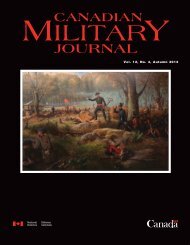Create successful ePaper yourself
Turn your PDF publications into a flip-book with our unique Google optimized e-Paper software.
Author’s collection PA203226<br />
The chandelier, as the underslung carriage was known, from the balloon forced<br />
down near Coal Harbour was recovered intact. The picture shows the overall size<br />
of the sandbags and equipment carried by the balloon. It also includes the small<br />
battery target at which RCAF pilots were instructed to shoot to bring down a<br />
balloon intact.<br />
This Command had numerous concerns with respect<br />
to the balloons, including the gathering of intelligence<br />
about them, since understanding the nature of the threat<br />
could better enable development of effective<br />
countering actions. It was initially believed<br />
that they had been designed to start forest<br />
fires, or that they posed a biological hazard<br />
threat, designed to either threaten humans<br />
or livestock. 4<br />
Secondly, there was the issue of<br />
detecting and reporting the balloons, and<br />
then managing the response. Related to<br />
this were questions as to whether civilian<br />
pilots should be informed, and how could<br />
WAC ensure the accuracy both of balloon<br />
reports received and then of reports sent<br />
to higher headquarters. Thirdly, WAC’s<br />
actions had to conform, not only to<br />
“Western Air<br />
Command was the<br />
first of the RCAF<br />
commands to become<br />
aware that Japanese<br />
balloons were<br />
incurring upon the<br />
airspace over the<br />
western part of<br />
North America...”<br />
the directives and requirements of AFHQ,<br />
but to the needs of the regional Joint Service<br />
Committee (JSC), the committee composed<br />
of representatives of the three services on the<br />
west coast and mandated to coordinate matters<br />
of common concern.<br />
Of all the concerns, that of the WAC’s<br />
relationship with the other Pacific-based forces<br />
is perhaps the most important. The Command<br />
could not operate in isolation, thereby ensuring<br />
that its actions would have an impact on the<br />
other services on the west coast. Therefore,<br />
how WAC reacted to the balloon threat from<br />
its earliest period is of great interest.<br />
Early Innings<br />
Western Air Command was the first of the<br />
RCAF commands to become aware that<br />
Japanese balloons were incurring upon the<br />
airspace over the western part of North America,<br />
and, subsequently, to prepare a countering defence<br />
plan. At a staff meeting on 11 January 1945,<br />
the balloon issue was tabled for the first time,<br />
but with no specific insight as to the nature<br />
of the threat or if counter-measures were<br />
required. 5 However, this did not mean that<br />
WAC was inactive or disinterested. In fact, it<br />
was prepared to detect and recover balloons<br />
without support from the other services.<br />
Air Vice-Marshal F.V. Heakes, the Air Officer<br />
Commanding (AOC) Western Air Command,<br />
had already started coordinating information and<br />
actions with comparable American authorities,<br />
and had appointed a “special balloon investigator”<br />
to gather information and carry out the liaison<br />
function. At the same time, one aircraft at each<br />
base was ordered to be maintained on stand-by “to<br />
investigate” further sightings. 6 AFHQ supported this<br />
position, and in an effort to recover balloons intact<br />
for further study and analysis, sent a message on<br />
20 January indicating that the recovery of intact balloons was<br />
“extremely desirable.” 7 In a directive of 23 January, AFHQ<br />
indicated that information about the balloons was to be<br />
circulated among the respective western<br />
RCAF headquarters. Western Air Command<br />
was also to pass copies of all reports to<br />
the appropriate US authorities. 8<br />
The Command was allowed to act<br />
relatively independently, as the overall<br />
perception of the threat was low. On<br />
19 January, Air Vice-Marshal Heakes’s<br />
evaluation was that the balloons were of<br />
“no immediate significance,” except possibly<br />
for their psychological value or for<br />
reconnaissance. He further speculated as to<br />
whether the balloons had been designed<br />
to create forest fires and suggested<br />
submarines were releasing them. 9<br />
60 Canadian Military Journal ● Summer 2005





